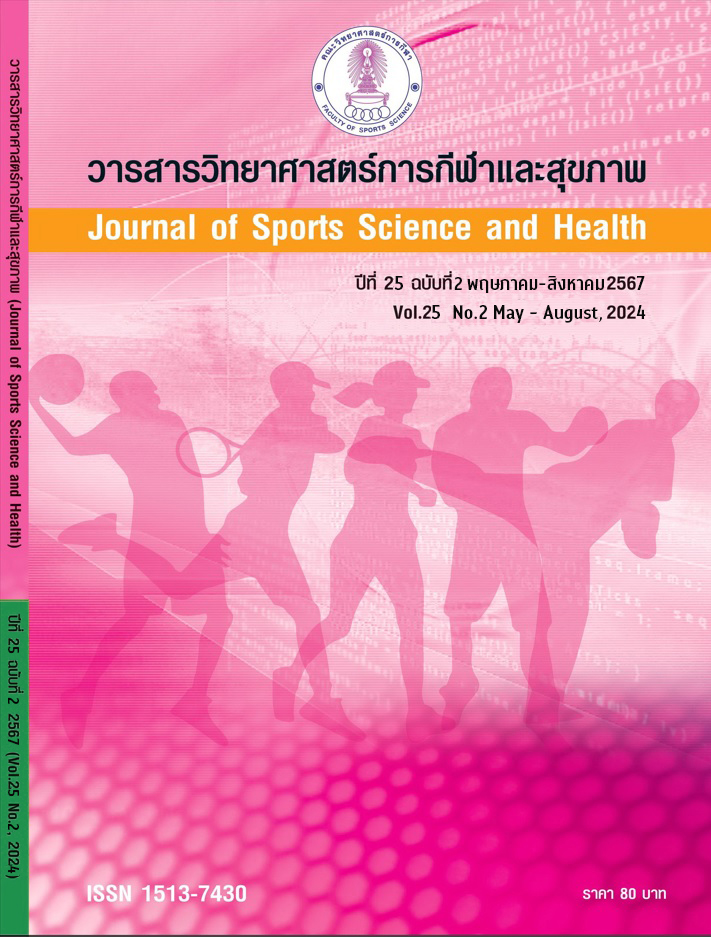EFFECTS OF THE COMBINATION OF AMINO ACID SUPPLEMENT AND RESISTANCE TRAINING ON BODY COMPOSITION AND MUSCULAR FITNESS IN HEALTHY PEOPLE
Main Article Content
Abstract
Purpose
To investigate the effects of the combination of amino acid supplement and resistance training on body composition and muscular fitness in healthy people.
Methods
Participants in this study were those who were 30 healthy males and females aged between 25-50 years old. They were randomly divided into control group (CON) received resistance training only and experimental group (AA+RT) received essential amino acid powder and resistance training for a total 12 weeks. Body composition, muscle strength, and muscle size were carefully monitored before, at 6 weeks, and 12 weeks of the program. Then, SPSS software was utilized to perform the statistical analysis with Mixed-model ANOVA with LSD post hoc test. The p value less than 0.05 was set as the statistical significance.
Results
After 12 weeks, AA+RT showed the decreased body fat mass (p<0.05) when compared with before training. While there were no significant differences on control group (p>0.05). Moreover, arms and legs muscle strength, circumference, and thickness were significantly increased at week 6 and the end of 12 weeks in both groups with no significant differences among groups (p>0.05).
Conclusion
The combination of amino acid supplement and resistance training can improve body composition greater than resistance training alone while muscular strength and size were similar.
Article Details

This work is licensed under a Creative Commons Attribution-NonCommercial-NoDerivatives 4.0 International License.
References
Akram, M., Asif, H., Uzair, M., Akhtar, N., Madni, A., Shah, S. A., Hasan, Z., and Ullah, A. (2011). Amino acids: a review article. Journal of Medicinal Plants Research, 5(17), 3997-4000.
Andersen, L. L., Tufekovic, G., Zebis, M. K., Crameri, R. M., Verlaan, G., Kjær, M., Suetta, C., Magnusson, P., and Aagaard, P. (2005). The effect of resistance training combined with timed ingestion of protein on muscle fiber size and muscle strength. Metabolism, 54(2), 151-156.
American college of sports medicine. (2013). ACSM's guidelines for exercise testing and prescription. Pune: Wolters Kluwer.
American college of sports medicine. (2018). ACSM's Guidelines for Exercise Testing and Prescription. Pune: Wolters Kluwer.
Ballor, D. L., and Poehlman, E. (1992). Resting metabolic rate and coronary-heart-disease risk factors in aerobically and resistance-trained women. The American Journal of Clinical Nutrition, 56(6), 968-974.
Bird, S. P., Tarpenning, K. M., and Marino, F. E. (2006). Independent and combined effects of liquid carbohydrate/essential amino acid ingestion on hormonal and muscular adaptations following resistance training in untrained men. European Journal of Applied Physiology, 97(2), 225-238.
Børsheim, E., Tipton, K. D., Wolf, S. E., and Wolfe, R. R. (2002). Essential amino acids and muscle protein recovery from resistance exercise. American Journal of Physiology. Endocrinology and Metabolism, 283(4), 648-657. https://doi.org/10.1152/ajpendo.00466.2001
Burd, N. A., Tang, J. E., Moore, D. R., and Phillips, S. M. (2009). Exercise training and protein metabolism: influences of contraction, protein intake, and sex-based differences. Journal of Applied Physiology, 106(5), 1692-1701.
Chilibeck, P. D., Calder, A. W., Sale, D. G., and Webber, C. E. (1997). A comparison of strength and muscle mass increases during resistance training in young women. European Journal of Applied Physiology and Occupational Physiology, 77(1), 170-175.
Dideriksen, K., Reitelseder, S., Holm, L. (2013). Influence of amino acids, dietary protein, and physical activity on muscle mass development in humans. Nutrients. 5(3), 852-876.
Grgic, J., Garofolini, A., Orazem, J., Sabol, F., Schoenfeld, B. J., and Pedisic, Z. (2020). Effects of resistance training on muscle size and strength in very elderly adults: a systematic review and meta-analysis of randomized controlled trials. Sports Medicine, 50(11), 1983-1999.
Hulmi, J. J., Lockwood, C. M., and Stout, J. R. (2010). Effect of protein/essential amino acids and resistance training on skeletal muscle hypertrophy: a case for whey protein. Nutrition & Metabolism, 7(1), 51. https://doi.org/10.1186/1743-7075-7-51
Hulmi, J. J., Tannerstedt, J., Selanne, H., Kainulainen, H., Kovanen, V., and Mero, A. A. (2009). Resistance exercise with whey protein ingestion affects mTOR signaling pathway and myostatin in men. Journal of Applied Physiology, 106(5), 1720-1729.
Hunter, G. R., Weinsier, R. L., Bamman, M. M., and Larson, D. E. (1998). A role for high intensity exercise on energy balance and weight control. International Journal of Obesity, 22(6), 489-493.
Koopman, R., and Van Loon, L. J. (2009). Aging, exercise, and muscle protein metabolism. Journal of Applied Physiology, 106(6), 2040-2048.
Li, P., Yin, Y. L., Li, D., Kim, S. W., and Wu, G. (2007). Amino acids and immune function. The British Journal of Nutrition, 98(2), 237-252.
Morat, M., Faude, O., Hanssen, H., Ludyga, S., Zacher, J., Eibl, A., Albracht, K., and Donath, L. (2020). Agility training to integratively promote neuromuscular, cognitive, cardiovascular and psychosocial function in healthy older adults: a study protocol of a one-year randomized-controlled trial. International Journal of Environmental Research and Public Health, 17(6), 1853. https://doi.org/10.3390/ijerph17061853
Ormsbee, M. J., Thyfault, J. P., Johnson, E. A., Kraus, R. M., Choi, M. D., and Hickner, R. C. (2007). Fat metabolism and acute resistance exercise in trained men. Journal of Applied Physiology, 102(5), 1767-1772.
Phillips, S. M., and Winett, R. A. (2010). Uncomplicated resistance training and health-related outcomes: evidence for a public health mandate. Current Sports Medicine Reports, 9(4), 208-213.
Thanalerdsomboon, B., and Chuensiri, N. (2023). Effects of weightlifting derivatives on core limb muscle strength in female office workers. Journal of Sports Science and Health, 24(3), 106-124.
Schiaffino, S., Dyar, K. A., Ciciliot, S., Blaauw, B., and Sandri, M. (2013). Mechanisms regulating skeletal muscle growth and atrophy. FEBS Journal, 280(17), 4294-4314.
Willoughby, D. S., Stout, J. R., and Wilborn, C. D. (2007). Effects of resistance training and protein plus amino acid supplementation on muscle anabolism, mass, and strength. Amino Acids, 32(4), 467-477.


